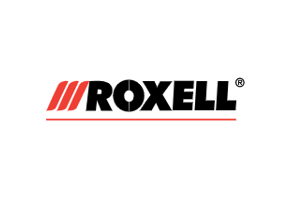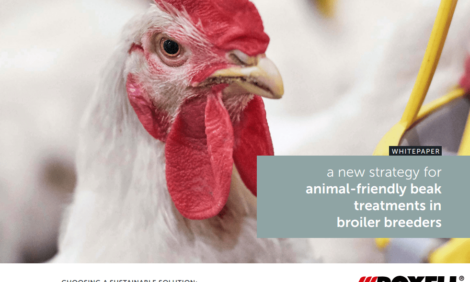



Animal-friendly beak treatments. Research results: Rearing
A new strategy for animal-friendly beak treatments in Broiler Breeders pt.3Part of Series:
< Previous Article in Series Next Article in Series >
The benefits of Natural Beak Smoothing are clear. But poultry integrations and hatcheries often want to see case studies from other poultry companies that have already made the switch. Roxell and its distributors have realized many successful installations in previous years. In 2020, we launched a test in collaboration with Couvoir Perrot, a hatchery in France. The French division of Aviagen monitored the test and were one of the impartial parties assessing the beaks.
There was a test set-up with Natural Beak Smoothing at broiler breeder company Entreprise EARL Chevillard, where we monitored the broiler breeders over 20 rearing weeks. After this period, we monitored them up to week 64. In this chapter, we will compare the results from the house with IR treatment A , the house with Natural Beak Smoothing B and the house without treatment C . Below, you can see the most important figures and conclusions from this test.
Test method with Natural Beak Smoothing
- 5 test partners: le Couvoir Perrot (hatchery), Entreprise EARL Chevillard (broiler breeder company), Aviagen (breeder), Sodimel (Roxell distributor) and Roxell (Natural Beak Smoothing developer).
- Location: Saint-Malon-sur-Mel, France
- Test in 3 houses:
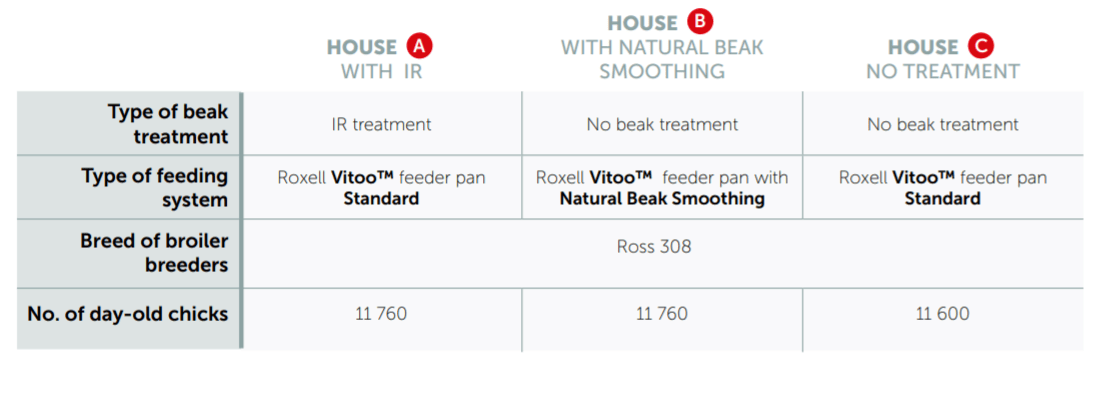
Rearing
The results during the rearing period with hens
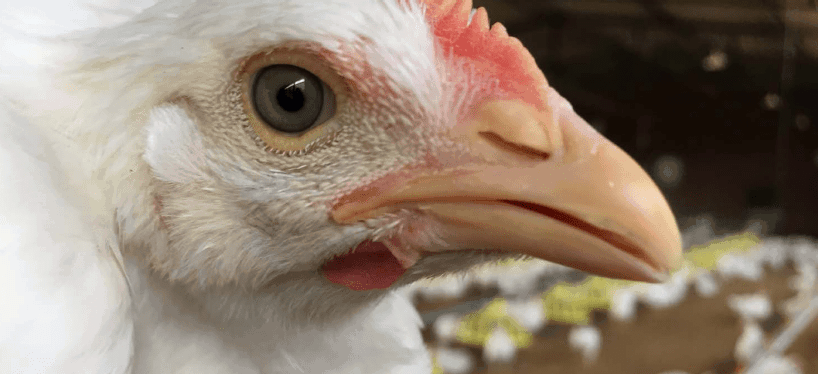
1. Evolution of beak shape - overbite and sharpness
The test partners assessed the beaks of the hens at two points during the rearing period: week 14 and week 20. In the production period, there was one review moment in week 58 .
- Visual checks for two aspects: overbite and sharpness of the beaks
- Possible score: poor, acceptable and excellent
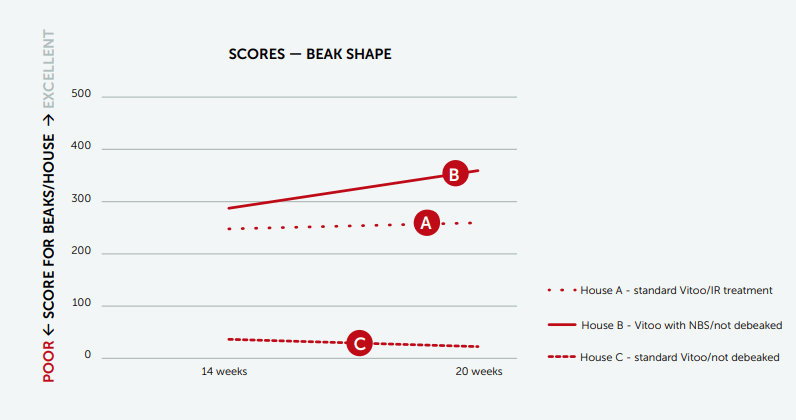
Conclusion: only in house B with Natural Beak Smoothing did the scores for beaks significantly improve between week 14 and week 20:
- House B – NBS: in week 20 – 92 % were given a score of ‘acceptable’ or ‘excellent’ of which 51 % ‘excellent’
- House A – IR:in week 20 – 76 % were given a score of ‘acceptable’ or ‘excellent’ of which 27 % ‘excellent’
- House C – with no treatment: in week 20 – most scored ‘poor’ due to excessive overbites and sharp beaks
2. Mortality rate
The difference in mortality rates between the three houses was insignificant in this test due to two reasons:
- the chicks had diverse backgrounds — up to four different batches per house
- the grandparent stock did not have identical ages (between 30 and 55 weeks)
Conclusion: Couvoir Perrot shared that – in earlier tests – skipping the IR treatment resulted in 0.5 % fewer deaths among day-old chicks
3. Feed savings
During the test, we monitored the feed consumption per hen, per day in a period of 20 rearing weeks.

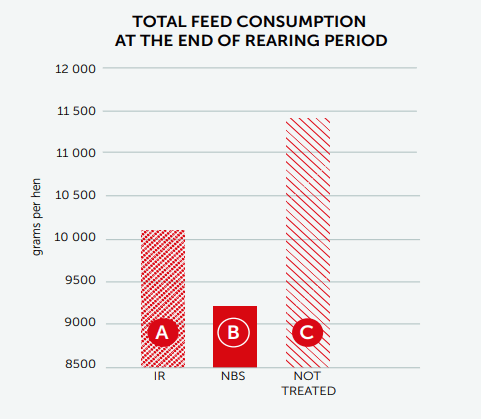
Conclusion: hens with beautifully smoothed beaks waste less feed. A comparison:
- House B – NBS: savings of 6.3 g/hen/day (0.22 oz) compared with House A – IR
- House B – NBS: savings of 15.8 g/hen/day (0.56 oz) compared with House C – no treatment
- House B – NBS: 10 170 kg/flock (22 421 lb) less feed used compared with House A – IR or €3561/flock (or $4148) at a feed price of €350/tonne ($370/US ton)
- House C – no treatment: the hens had to remain one week longer in the rearing house due to
uniformity problems and inadequate sexual development

4. Body Weight
It bears noting that hens with a low body weight always had a poor scoring beak. Therefore, there is a link between beak irregularities and difficulties with eating and drinking.
Conclusion: in all three houses, the body weight fell within the usual range at the end of the rearing period. However, it took House C – no treatment, one week longer to complete the rearing period and reach the targeted uniformity and sexual development.
- House A – IR: average weight of the hens 2356 grams (83.11 oz) after 20 weeks
- House B – NBS: average weight of the hens 2418 grams (85.29 oz) after 20 weeks
- House C – no treatment: average weight of the hens 2321 grams (81.87 oz) after 21 weeks
5. Conclusion: Optimal uniformity with IR or natural beak smoothing
The ultimate goal of the rearing period was successfully achieved: the house with Natural Beak Smoothing was the most uniform of all three houses after 20 weeks. To reach this result, the hens in the house with Natural Beak Smoothing used the least feed.
In general, this research showed that the beaks remain growing continually:
- with Natural Beak Smoothing, this is less of an issue because the beak is constantly maintained by the file in the bottom pan. It’s a gradual process and in the second half of the rearing period the beaks were perfectly smooth. This gave this group of hens a head start in the production phase.
- with IR treatment, the scores for the beaks already began decreasing in the second half of the rearing period. This resulted in a poorer performance in the production phase compared with the hens with Natural Beak Smoothing.
- without treatment the hens needed an extra week to get ready to move to the production period. Pecking up feed is difficult with untreated beaks. After an extra week in the house, the uniformity of this group also fell within the usual range.
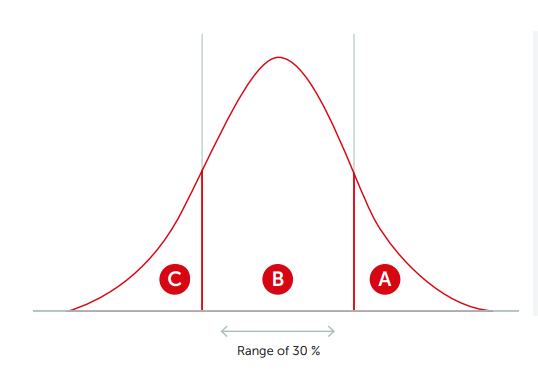
Overview of results with Natural Beak Smoothing in rearing period:
- the shape of the beaks scores the best and improves throughout, which is not the case with IR treatment
- large savings on feed costs
- savings on recurrent treatment costs
- this group of hens achieved the best uniformity







